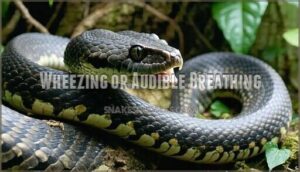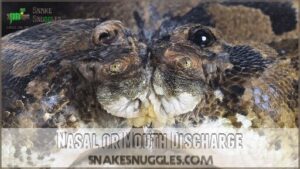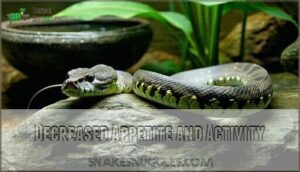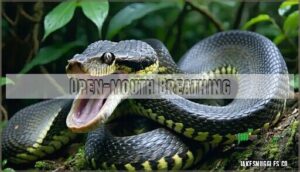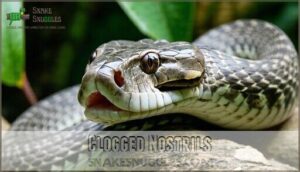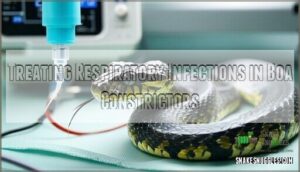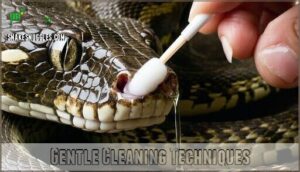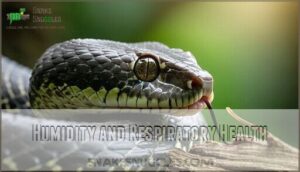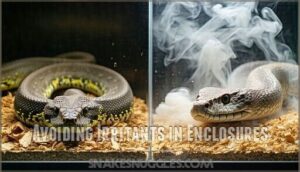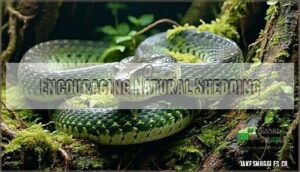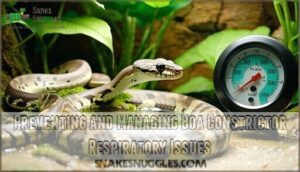This site is supported by our readers. We may earn a commission, at no cost to you, if you purchase through links.
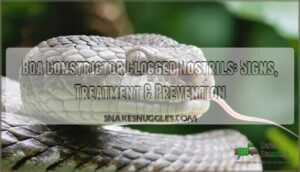
This issue often stems from low humidity levels, stuck shed skin, or respiratory infections. You’ll want to check your enclosure’s humidity first – it should sit between 50-60%.
Look for crusty discharge or labored breathing, which signals trouble. Gently increase humidity and monitor your snake closely.
If the blockage persists beyond a few days, schedule a vet visit immediately. Respiratory infections can escalate quickly in boas.
The good news? Most nostril problems are preventable with proper care and the right environmental tweaks.
Table Of Contents
- Key Takeaways
- Recognizing Signs of Respiratory Infection in Boa Constrictors
- Common Symptoms of Respiratory Infections
- Treating Respiratory Infections in Boa Constrictors
- Cleaning and Maintaining Snake Nostrils
- Preventing and Managing Boa Constrictor Respiratory Issues
- Frequently Asked Questions (FAQs)
- How to care for a boa constrictor?
- Can a boa constrictor cause a respiratory infection?
- Do boa constrictors have mouth rot?
- Why is my Boa Constrictor taking a soak?
- How do you know if a boa constrictor is threatened?
- Do boa constrictors have fangs?
- How to unclog a snakes nose?
- Can snakes get a stuffy nose?
- What illness do boa constrictors have?
- How do I get my boa constrictor to let go?
- Conclusion
Key Takeaways
- You’ll prevent most nostril blockages by maintaining humidity levels between 50-60% and providing proper ventilation in your boa’s enclosure.
- You should watch for warning signs like crusty discharge, wheezing sounds, open-mouth breathing, and decreased appetite that signal respiratory infection requiring immediate vet care.
- You can gently clear minor blockages with warm water soaks for 15-30 minutes or use damp cotton swabs, but don’t push debris deeper into the nostrils.
- You must seek veterinary treatment if symptoms persist beyond a few days, as respiratory infections escalate quickly and require antibiotic treatment for recovery.
Recognizing Signs of Respiratory Infection in Boa Constrictors
Three telltale signs can help you spot a respiratory infection in your boa constrictor before it becomes serious.
Spotting respiratory infection early in your boa constrictor can save its life—listen, observe, and act quickly for better outcomes.
First, listen for unusual breathing sounds.
Healthy snakes breathe silently, but respiratory infection causes wheezing, clicking, or rattling noises.
These breathing difficulties signal trouble brewing in your snake’s respiratory system.
Watch your boa’s behavior closely.
Appetite changes often appear first—your normally enthusiastic eater might refuse meals entirely.
Activity levels drop too.
A snake that usually explores its enclosure may become lethargic and stay in one spot.
Look for discharge appearance around the mouth or nostrils.
Clear, foamy, or colored mucus indicates infection.
Early symptoms include subtle changes in breathing patterns and reduced responsiveness.
Beyond respiratory issues, be aware that neurological abnormalities can also manifest.
Your boa constrictor’s reptile breathing should be nearly invisible.
When you notice obvious chest movements or open-mouth breathing, it’s time for immediate veterinary attention.
Snake respiratory health requires quick action.
Common Symptoms of Respiratory Infections
You’ll notice respiratory infections in your boa through several clear warning signs that affect breathing and behavior.
These symptoms range from obvious breathing sounds to changes in appetite and activity levels, which can be considered complete concepts to observe for diagnosis.
Wheezing or Audible Breathing
Your boa constrictor’s breathing sounds can reveal vital information about its respiratory health.
When respiratory infections take hold, you’ll notice distinct wheezing or audible breathing that wasn’t there before.
These breathing sounds indicate compromised lung health and require immediate attention.
Respiratory distress in boas manifests as:
- Labored breathing with whistling or crackling sounds
- Increased effort during inhalation and exhalation
- Occasional open-mouth breathing attempts
Early detection of these symptoms prevents serious complications.
The infection severity escalates quickly without intervention.
Recognizing signs of respiratory issues is crucial for timely intervention.
Environmental impact plays a significant role – poor ventilation and humidity levels worsen reptile breathing problems.
Don’t wait when you hear unusual snake nostrils sounds.
Nasal or Mouth Discharge
Mucous discharge signals your boa’s respiratory distress. You’ll spot clear to colored secretions around snake nostrils, indicating nostril blockage or nasal congestion.
This clogged nostrils condition ranges from thin, watery drainage to thick, crusty buildup.
| Discharge Color | Veterinary Urgency |
|---|---|
| Clear/White | Monitor closely |
| Yellow/Green | Seek vet within 24-48 hours |
| Bloody/Brown | Emergency care needed |
| Foamy/Frothy | Immediate attention required |
Discharge consistency and discharge frequency help determine underlying causes requiring professional treatment.
Decreased Appetite and Activity
When your boa constrictor shows decreased appetite and activity, it’s like watching a normally energetic friend suddenly hit the couch for days.
This lethargy causes concern because reduced movement often signals snake illness.
Watch for these anorexia signs:
- Refusing food for multiple feeding cycles
- Spending excessive time hiding or motionless
- Sluggish responses to handling or stimuli
- Weight loss despite proper feeding schedule
- General inactivity impact on normal behaviors
These energy levels changes alongside respiratory symptoms require immediate veterinary attention for proper boa illness diagnosis.
Open-mouth Breathing
When your boa constrictor breathes with its mouth open, it’s signaling severe distress.
This snake breathing problems symptom means nasal congestion is forcing your pet to find alternative airways. Openmouth breathing often indicates glottis blockage from a respiratory infection.
Unlike temporary shedding issues, persistent mouth breathing demands immediate action. Contact an emergency vet within hours—prognosis factors improve dramatically with quick intervention before complications develop.
Clogged Nostrils
When your boa constrictor’s nostrils become blocked, you’ll notice clear warning signs that shouldn’t be ignored. Clogged nostrils in reptiles often signal underlying health issues requiring immediate attention.
Watch for these key symptoms of snake nostril blockage:
- Visible discharge or mucus buildup around the nostrils
- Foreign objects like shed skin or substrate particles
- Swelling or irritation around the nasal area
- Labored breathing or increased respiratory effort
These causes indicate serious conditions requiring professional remedies and prevention measures, which is why it’s crucial to identify the symptoms of snake nostril blockage, such as visible discharge, to ensure timely intervention.
Treating Respiratory Infections in Boa Constrictors
When your boa constrictor shows signs of a respiratory infection, you’ll need to act quickly to get proper treatment.
Quick action saves lives—respiratory infections in boas demand immediate veterinary care, not wait-and-see approaches.
Effective treatment requires a combination of veterinary care, antibiotics, and creating the right environment to support your snake’s recovery**.
Veterinary Examination and Diagnosis
When symptoms point to respiratory trouble, your snake needs professional help fast.
A reptile vet will conduct a thorough veterinary examination to pinpoint what’s causing the snake nostril blockage.
The veterinary diagnosis process starts with checking your boa’s breathing patterns and looking for discharge around the nostrils and mouth.
Diagnostic procedures typically include sample collection from the mouth or nostrils to identify harmful bacteria or fungi.
Your vet might recommend imaging techniques like X-rays to check for pneumonia or lung damage.
Blood tests help assess your snake’s immune response.
This differential diagnosis approach helps rule out other conditions that mimic respiratory infections.
Once the vet completes these diagnostic tests, they’ll develop a targeted treatment planning strategy for your boa’s recovery.
Antibiotic Treatment
After your reptile vet diagnoses a bacterial infection, they’ll prescribe specific antibiotic treatment suited to your snake’s needs.
Antibiotic Types like enrofloxacin or ceftazidime target respiratory pathogens effectively. Your vet handles Dosage Calculation based on your boa’s weight and infection severity.
Treatment Duration typically spans several weeks—don’t skip doses even if your snake seems better. Watch for Side Effects like appetite loss.
For more information, consult boa constrictor care resources. Following the complete regimen prevents Resistance Prevention issues that make future snake infections harder to treat.
Your reptile vet monitors progress through follow-up visits to guarantee snake health recovery.
Supportive Care and Environment
Beyond antibiotics, your boa constrictor needs proper supportive care to bounce back from respiratory infections.
Creating the right environment acts like a healing sanctuary for your snake’s recovery.
Focus on these critical environmental factors:
- Humidity Control: Maintain 60-70% humidity levels to support respiratory function and natural shedding
- Temperature Gradient: Provide consistent basking spots and cooler areas for thermoregulation
- Water Quality: Offer fresh, clean water daily to prevent dehydration
Monitor your snake’s behavior closely.
A stress-free, quiet enclosure promotes faster healing while proper Substrate Choice reduces irritation.
Maintaining proper humidity is essential, so consider specialized humidity products.
Avoiding Exposure to Irritants
Creating a clean environment starts with eliminating common irritants that can worsen your boa’s respiratory issues.
Dust-free substrates prevent particles from entering sensitive nasal passages, while proper air filtration removes airborne contaminants.
Chemical avoidance means switching to reptile-safe products for enclosure cleaning—harsh cleaners can irritate delicate respiratory tissues.
Ventilation quality directly impacts air freshness, so maintain steady airflow without creating drafts.
Maintain stable humidity levels between 50-60% to prevent mold growth.
Regular substrate change every few weeks removes accumulated debris and bacteria that could compromise your snake’s breathing.
Ensure proper care by following these guidelines to create a healthy environment for your boa.
Monitoring and Follow-Up Care
After starting your boa constrictor’s treatment, keep watching like a hawk.
Your reptile vet will want updates on breathing patterns and appetite changes.
Stick to the medication schedule religiously – missing doses can set back recovery.
Long-term Prevention means maintaining Environment Consistency and proper Hydration Importance for ideal reptile health.
- Shedding Observation: Watch for incomplete sheds that signal lingering respiratory issues
- Behavior Changes: Note any lethargy or unusual positioning that might indicate ongoing problems
Cleaning and Maintaining Snake Nostrils
You can keep your boa’s nostrils clean and healthy with simple daily care routines. Regular cleaning prevents blockages that lead to breathing problems and respiratory infections.
Gentle Cleaning Techniques
Three simple methods can safely clear your boa constrictor’s clogged nostrils without causing stress.
Start with warm water soaks in tepid water for fifteen minutes—this works as excellent shedding aid for stuck skin.
Before handling, remember to follow proper hygiene practices to minimize the risk of transmitting pathogens.
For stubborn blockages, use a cotton swab dipped in mild saline solution made from non-iodized salt and distilled water.
Apply gentle cleaning techniques with minimal pressure, never pushing debris deeper.
These preventative cleaning methods maintain respiratory health while keeping your snake comfortable throughout the process.
Humidity and Respiratory Health
With proper humidity importance for your boa constrictor, you’ll prevent most clogged nostrils before they happen.
Keep levels between 50-60% to maintain healthy respiratory passages and avoid shedding difficulties.
When your snake prepares to shed, bump humidity higher to help the process along. Hydration effects play a vital role too—well-moisturized snakes shed completely, reducing nostril blockages.
Consider using a reliable humidity gauge to monitor enclosure conditions.
Think of humidity as your snake’s natural air conditioning system that keeps everything running smoothly.
Avoiding Irritants in Enclosures
Your boa constrictor’s enclosure needs protection from irritants that can cause clogged nostrils and respiratory problems.
Chemical exposure from household cleaners poses serious risks to your snake’s delicate respiratory system. Choose reptile-safe disinfectants and maintain proper air quality through adequate ventilation.
Key considerations for a safe environment:
- Select dust-free safe substrates like paper towels instead of cedar or pine shavings
- Verify plant toxicity isn’t an issue by researching before adding vegetation
- Monitor humidity levels while keeping irritants away
Encouraging Natural Shedding
After keeping irritants away from your boa constrictor, proper humidity becomes your best friend for preventing clogged nostrils.
Maintain 60-70% humidity during shedding cycles to help skin come off cleanly.
Provide a humid hide box and guarantee fresh water availability.
Good substrate choice matters too—avoid dusty materials that stick to shedding skin.
Monitor shedding frequency to catch problems early.
Preventing and Managing Boa Constrictor Respiratory Issues
You can prevent most respiratory problems in your boa constrictor by maintaining proper enclosure conditions and watching for early warning signs.
Clean your snake’s habitat regularly, keep humidity levels between 50-60%, and monitor your pet’s breathing patterns to catch issues before they become serious.
Regular Enclosure Maintenance
A clean home keeps your boa constrictor healthy and prevents clogged nostrils. Daily maintenance stops bacteria from building up in your snake’s enclosure. Weekly deep cleaning removes hidden contaminants that could cause respiratory problems. Proper ventilation is also key to preventing respiratory issues.
Follow these steps for regular enclosure maintenance:
- Daily spot cleaning – Remove waste, uneaten food, and soiled substrate immediately
- Weekly deep cleaning – Disinfect surfaces with reptile-safe products only
- Substrate selection – Choose dust-free materials like cypress mulch or paper towels
- Water quality – Replace water bowls twice weekly with dechlorinated water
Proper Humidity and Ventilation
Maintaining ideal humidity levels between 50-60% is vital for your boa constrictor’s respiratory health.
Use a reliable hygrometer to monitor your enclosure consistently. You can find a suitable boa hygrometer here.
Ventilation methods like cross-ventilation or small fans prevent stagnant air while preserving humidity control. Enclosure design should include a large water dish and regular misting for ideal humidity importance.
These practices guarantee shedding success and reduce respiratory infection risks, keeping your snake breathing comfortably year-round.
Quarantine Practices for New Additions
Proper quarantine practices for new additions protect your entire collection from potential health threats.
Set up a separate enclosure in an isolated room, maintaining at least 10-15 feet from existing snakes.
Your quarantine duration should span 3-6 months, not just 30 days.
Use separate tools exclusively for quarantined boa constrictors to prevent cross-contamination.
Implement strict health monitoring with daily visual inspections and stress reduction techniques.
Always handle quarantined snakes last, washing hands thoroughly afterward.
Contact a reptile vet if concerning symptoms appear during isolation.
Monitoring Behavioral and Physical Changes
Regular physical inspections reveal vital health information about your boa constrictor.
Watch for behavioral changes like altered eating habits and activity levels.
Monitor shedding patterns for incomplete sheds that cause clogged nostrils.
Look for labored breathing, unusual posturing, or discoloration—early warning signs of respiratory infection.
Catching snake health issues early prevents serious complications through consistent observation.
Frequently Asked Questions (FAQs)
How to care for a boa constrictor?
Your boa needs consistent humidity between 50-60%, temperatures around 80-88°F, and a spacious enclosure with hiding spots.
Feed appropriately-sized prey every 2-3 weeks, provide fresh water, and monitor for health issues regularly.
Can a boa constrictor cause a respiratory infection?
While boas don’t directly cause respiratory infections in humans, they can carry bacteria or parasites that might contribute to respiratory issues.
However, you’re more likely to develop breathing problems from poor enclosure hygiene or allergens.
Do boa constrictors have mouth rot?
Like a kingdom under siege, your snake’s mouth can fall victim to infectious invaders.
Yes, boa constrictors develop mouth rot when bacteria attack their oral tissues, causing inflammation, discharge, and tissue damage requiring immediate veterinary treatment.
Why is my Boa Constrictor taking a soak?
Your snake’s probably preparing to shed its skin or trying to boost humidity levels.
Soaking helps loosen old skin and maintains proper hydration.
It’s completely normal behavior, especially before shedding cycles, which involves a completely normal process.
How do you know if a boa constrictor is threatened?
A coiled spring ready to strike, your threatened boa will ball up tightly, hiss loudly, and display defensive posturing.
Watch for rapid tail vibrations, defensive strikes, and an S-shaped neck position indicating stress.
Do boa constrictors have fangs?
No, boa constrictors don’t have fangs like venomous snakes. They’re equipped with rows of small, backward-curving teeth that help grip prey. These teeth aren’t hollow and can’t inject venom.
How to unclog a snakes nose?
Clear airways are your pet’s lifeline.
Gently soak your snake in warm water for 15-30 minutes to soften blockages.
Use damp cotton swabs carefully around nostrils.
For persistent issues, contact a reptile veterinarian immediately.
Can snakes get a stuffy nose?
Yes, your snake can definitely get a stuffy nose. Stuck shed skin, substrate particles, respiratory infections, and improper humidity levels commonly cause nostril blockages that make breathing difficult for snakes.
What illness do boa constrictors have?
Respiratory infections affect 30% of captive boas annually.
Your snake can develop eye problems, mouth rot, skin fungal infections, scale rot, parasites, and digestive issues requiring veterinary care for proper diagnosis and treatment, including veterinary care.
How do I get my boa constrictor to let go?
When your snake bites and won’t release, stay calm and avoid pulling.
Gently pour cold water over its head or apply rubbing alcohol to its mouth.
Never force the jaws open, as this damages teeth and stresses your pet.
Conclusion
Prevention remains worth a pound of cure when managing boa constrictor clogged nostrils.
You’ve learned to spot warning signs like discharge and labored breathing.
Maintaining proper humidity between 50-60% prevents most issues.
Clean enclosures and good ventilation protect your snake’s respiratory health.
Don’t delay veterinary care if symptoms persist beyond a few days.
With consistent monitoring and proper environmental controls, you’ll keep your boa breathing easily and living comfortably for years ahead, and prevention remains key, as it is always better to focus on proper humidity and good ventilation.
- https://www.reptifiles.com/red-tailed-boa-care/sick-boa/burns/
- https://www.vetexotic.theclinics.com/article/S1094-9194(02)00020-8/fulltext
- https://rvc-repository.worktribe.com/OutputFile/1552489
- https://boa-constrictors.com/en/interesting_facts_about_boa_constrictor/boa_constrictor_care/diseases
- https://www.researchgate.net/publication/376995409_Treatment_of_spectacular_dysecdysis_in_a_Boa_constrictor_snake_at_Lombok_Wildlife_Park_Nusa_Tenggara_Barat

